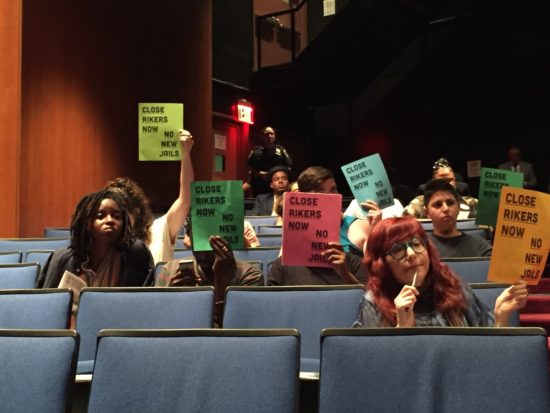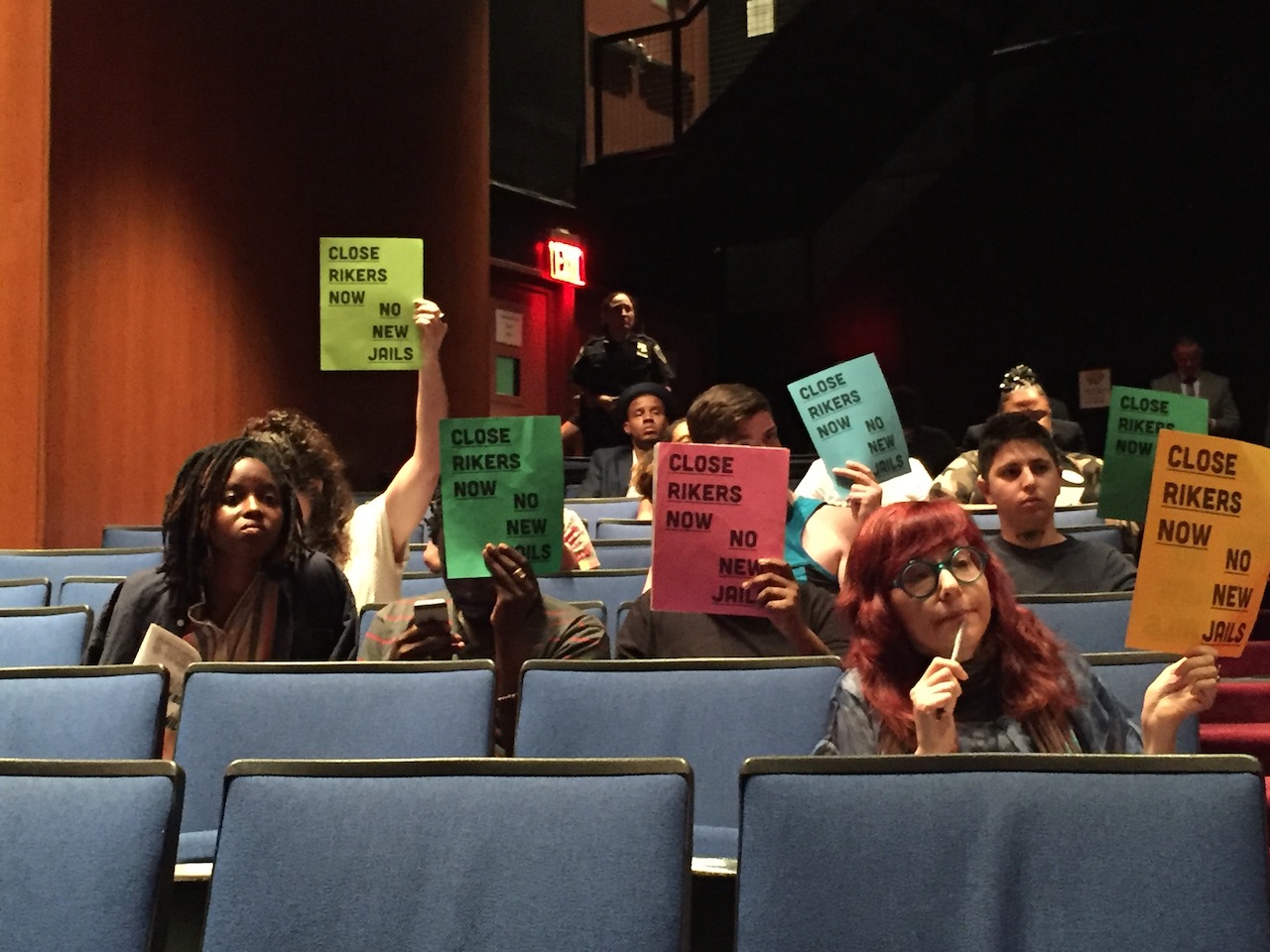
After Community Board 1 and borough president reject it, plan moves on in ULURP
A Mott Haven jail that would tower over schools a block away and house more than 1,000 detainees is not a recipe for community improvement, argued dozens of Bronxites at a City Planning Commission hearing on July 9 in Manhattan.
The Planning Commission’s decision about building new jails in the Bronx, Manhattan, Queens and Brooklyn marks the third of five official phases in the city’s Uniform Land Use Review Process (ULURP) on Mayor Bill de Blasio’s proposal to replace the jails on Rikers Island within a decade.
The public hearing was the first to take place outside of the boroughs where the jails are planned since the mayor announced the proposal early last year. So far, all four community boards and three of the four borough presidents alike voted down the plan. The only borough president to approve the plan, Manhattan’s Gail Brewer, did so with a host of stipulations.
The proposal for a Bronx facility with 1,125 beds on E. 141st Street and Concord Avenue, has already met with resistance from residents and elected officials at multiple public meetings in April and May in Mott Haven, and again from Bronx Borough President Ruben Diaz on July 2. In casting his no vote, Diaz told officials from the Mayor’s Office on Criminal Justice that “Throughout this process the city has refused to address the concerns of The Bronx.” He insisted he would “remain steadfast in my opposition to any plan that not only builds a new jail at the wrong location, but also refuses to address the legitimate concerns raised by individuals and organizations on all sides of the issue,” and added that “the Mott Haven community would be better served through a reinvestment of city resources into the surrounding area.”
Diaz and Communty Board 1 have urged the mayor and city planners to build the new jail on the site of a parking lot next to the criminal courthouse on E. 161st Street instead, but planners counter that the site is not big enough.
Although the community boards and borough presidents reviewed each of the four proposed jail sites separately, the Planning Commission is voting on them as a single proposal, as presented by the mayor’s office. That unusual move has raised the hackles of critics who say it is a ploy to force the Commission to review all of the plans simultaneously, without getting stuck on details for any one site.
In announcing his no vote at the Office of the Borough President on July 2, Diaz asked a city official how the Planning Commission deciding on all four sites at once would work.
“Does that mean that said-borough will still have to have that site even if everyone was against this ULURP, is that how this works?” he asked city officials at the meeting, but received no answer.
The commissioners heard hours of testimony in a packed auditorium at the John Jay College of Criminal Justice on W. 59th Street in Manhattan, from advocates from across the city for and against the jails.
Activists from the No New Jails grassroots movement were plentiful. Opponents jeered at city officials who lauded features of the new borough facilities, to include retail space, affordable housing and upscale food markets.
“Oh, please!” “Come on!” the crowd erupted when the executive director of the Department of City Planning Purinma Kapur brought up the new features. “Whole Foods underneath a jail,” one audience member shouted.
But other attendees, like Soundview resident Donna Hylton dismissed some of the opponents as outsiders who don’t understand the depth of the crisis. She and Sharon White-Harrigan, both former detainees at the Rose M. Singer Women’s Detention Center on Rikers Island or “Rosie’s,” said the time they served helped them understand the urgent need for more modern, smaller, jails in the boroughs. They support the city’s plan to build a new women’s facility in Queens.
“We have the lived experience of it,” said Hylton, who along with White-Harrigan is part of Beyond Rosie’s, a campaign calling for improved facilities and trauma services, as well as a nursery, for women in jail. Although she said she shares No New Jails’ ultimate goal of closing all jails some day, women who are in jail need help now, she said.
“None of NNJ has had any time or even visits or even does anything to support the people right now who are detained on Rikers,” she said.
One resident of the block where a Bronx jail would be built told the commissioners that the ULURP process’s provision that the public must provide feedback for proposed projects has not been fulfilled in Mott Haven.
“You hear from de Blasio’s office that there was a lot of input from the neighborhood: that is complete bullshit,” said Myra Hernandez. The only time Hernandez heard that Councilwoman Diana Ayala was convening a neighborhood advisory council for residents, Ayala, who favors the mayor’s plan, cancelled that meeting at the last minute, then continued to meet with residents on an invitation-only basis, critics allege. “That goes to show that these neighborhood advisory council meetings aren’t open to the public,” said Hernandez. “They only invite people that are proponents for the jail.”
Although ULURP allows the Planning Commission 60 days to deliberate on projects, which would leave the commissioners until September to vote on the jails proposal, the CPC is taking comments from the public only through Monday, July 22. According to the CPC’s website “All comments submitted through the form will be accepted until 11:59 PM, the week before the date of vote.” To comment, click on their website, (https://a002-irm.nyc.gov/EventRegistration/RegForm.aspx?eventGuid=fa206f3d-6400-4a95-8b39-87b1bfa975ef).
That indicates that the vote is likely to happen either at the Commission’s Monday, July 29 review session or at a public hearing, scheduled for Wednesday, July 31. That would leave the public less than half of the time ULURP normally allots to comment on projects going in front of the CPC.

